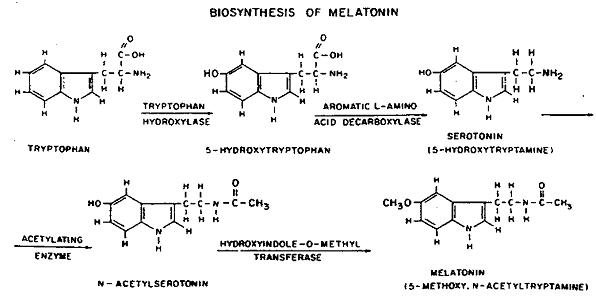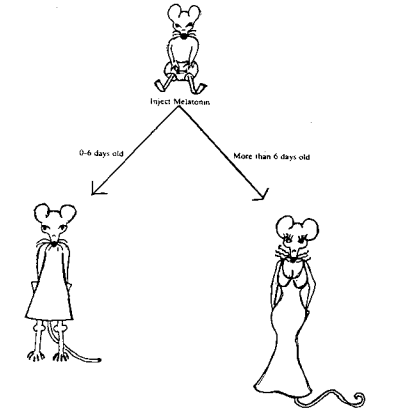Melatonin
It was soon established that the pineal gland produced a number of neuropeptides including one: 5-methoxy, N-acetyltryptamine, considered to be the most important of the pineal hormones and commonly called melatonin, (Figure 1).
The biosynthesis of melatonin was discovered to be dependent on a number of substrates and co-factors, and on the activity of a number of enzymes including the light-sensitive: hydroxy-indole-O-methyl transferase (HIOMT). (Lerner et al, 1958; 1959).
As Brownstein and Heller (1968) demonstrated, this enzyme – which catalyses the conversion of serotonin to melatonin – is modulated by nerves that impinge directly onto the pineal gland, the activity of which, in turn, depend upon input from the optic nerves. Thus a small proportion of the impulses set up in the optic nerves bypasses the main visual pathway and, instead, takes a circuitous route to the pineal. Stimulation of these nerves increases the activity of HIOMT and, hence, stimulates the synthesis of melatonin.
Bright light inhibits melatonin production by inhibiting nerve tone to the pineal, whereas darkness has the opposite effect and, by increasing neural activity to the gland, stimulates the production of melatonin. This effect of light is dependent both upon its wavelength and its intensity.
In 1973, Cardinali et al showed that red light produced minimal inhibition of melatonin synthesis, whereas green light caused maximal stimulation. In addition, illumination with a light intensity of 0.5 microwatt/cm2 for forty-eight hours produced a fifty per cent decrease in melatonin synthesis in the rat pineal gland.
By way of comparison, sunlight, which strongly inhibits melatonin production, has an intensity of around 50,000 microwatt/cm2, whereas full moonlight has an intensity of around 0.3 microwatt/cm2. (Altschule, 1975).
Because of its low light intensity, the moon was originally thought to have no effect on the production of melatonin by the pineal gland. However, as we discuss below, more recent studies have produced results that suggest there may be some link between lunar phase and the secretion of melatonin (Law, 1986).
In addition to light, other electromagnetic (EM) radiations influence melatonin production, and EM fields of varying strengths and types – including earth strength magnetic fields – have been shown to influence melatonin production to the same degree as the exposure to light does: both in vivo, and in vitro and in a number of species including humans (Reiter & Richardson, 1992; Reiter, 1993a,b; Schneider et al, 1994; Yaga et al, 1993). Further, magnetic fields of this general type have been found to be effective in directly stimulating pineal tissue (Richardson et al, 1992).
Human Studies
The change of the intensity of ambient lighting with season has long been considered to be a possible source of antigonadal activity in humans as well as animals and, in the late nineteenth century, a description was given in the medical literature of how Eskimo women ceased menstruation in the long winter nights of the Arctic (Cook, 1884).
Additional evidence was produced for a seasonal factor linked to reproduction and photoperiod when a positive bias towards summer conceptions in Finland was demonstrated, which showed an increase at more northerly latitudes. The fact that the incidence of multiple pregnancies was also increased at these latitudes strongly suggested that this was not an effect due to seasonal social influences, but that it was a true physiological effect due to an increased fertility associated with the longer periods of daylight that occur in the summer (Timonen & Carpen, 1968).
Other studies in humans suggested a possibly related phenomenon at work that also linked light to human reproductive processes. Thus Dewan (1967), and Dewan et al (1978), normalised irregular menstrual flow by using light midway through the menstrual cycle. Similarly, Elden (1971) demonstrated that, of one hundred and twenty predicted births in a sample of congenitally blind women, there was only one actual birth and, in an even larger sample, only six births occurred out of a predicted one thousand.
More recent studies have also shown that certain phenomena associated with hyperovulation – such as the incidence of twin births – are linked to both season and photoperiod. (Dionne et al, 1993; Fellman & Eriksson, 1999).
Thus with the discovery of the antigonadal activity of melatonin, and with the emergence of the fact that it was inhibited by light, we were starting to elucidate a more sophisticated mechanism to explain the effects of light-radiation on reproductive phenomena, one, moreover, that seemed to be closely related to the actual and putative effect(s) of melatonin on sexual development and hence to the effect of external EM radiation on the pineal gland.
However, one action of extraneously administered melatonin on sexual development that was identified early on by researchers in this area, appeared not only to be related to its antigonadal action, but to be dependent upon the age of the recipient when it was administered, also.
“Pre-Programming” from Birth
In a number of sophisticated studies of melatonin in animals, it appeared that, as with certain other hormones, the response of a neonatal animal to melatonin administration depended on precisely when the melatonin was administered in terms of chronological age. Thus it seemed that when melatonin was administered around the time of birth, it somehow produced changes in development that were delayed in onset until later in life and were therefore, in a biological sense, “pre-programmed” (Figure 2).
Further, these effects, which have been replicated in contemporary studies, appeared to influence both normal and pathological development (Arai, 1968; Esquifino, 1987; Vaughan & Vaughan, 1974).
It was also discovered that such changes in development did not take place if melatonin administration was delayed until a certain time after birth. Thus these delayed developmental effects of the hormone only occurred when it was administered at a set, critical time during the perinatal period.
As one researcher unambiguously stated in this context: “…alterations of the hormonal status of a neonate during a defined critical period [after birth] lead to profound sequelae in…subsequent biological function,” (Reiter et al, 1975a).
From consideration of this phenomenon it was clear that there were mechanisms involved that could potentially be of major significance to our long-term development. Thus: “neonatal administration of melatonin may cause…an abnormal secretion of biogenic amines in adulthood…” (Reiter et al, 1975b).
Such delayed-onset, or “pre-programming” effects of perinatally administered melatonin, while short lasting without reinforcement, were evident in a number of behavioural and physiological indices studied in animals, and they included, not only those associated with sexual development, but other developmental features also, including exploratory and maternal behaviour. Further, they could be produced either by the direct administration of melatonin, or by pinealectomy at birth, strongly suggesting a primary causal role for melatonin in these processes (Sampson, 1954; Sampson & Bigelow, 1971).
In addition, observations in humans where congenital blindness, or exposure to extremes of light-dark periods had been evident at the time of, and immediately after, birth, paralleled these findings; and studies in both congenitally blind women and in other groups continue to provide pertinent observations and findings in this respect (Boldsen, 1992; Commentz et al, 1997; Jaldo Alba et al, 1993a,b; Kennaway et al, 1992; Sans, 1977; Schmidt F, 1995).
Effects of Ambient Electromagnetic Radiation
Given that the production of melatonin is, amongst other things, controlled by the intensity and nature of ambient electromagnetic fields (EMFs) of geo-magnetic strength, then the intensity and orientation of the EM fields a neonate is exposed to perinatally could obviously alter the level of pineal melatonin in that neonate and, hence, influence its later development.
We know the exposure of neonatal animals to light significantly changes later melatonin secretion patterns, and we know that similar effects occur in human newborns (Fielke et al, 1994; Pelisek et al, 1994). We also know that, again, as in animals, EM radiations significantly alter circulation melatonin in humans (Graham et al, 1997; Juutilainen et al, 2000; Reiter, 1995).
There also appears to be a link between the geomagnetic field and developmental factors in humans. For example, the only significant factor that correlates with the development of epilepsy in young adults is the level of geomagnetic activity for two days after birth, and geomagnetic variables have also been considered to be a trigger for birth. There is also a significant correlation between the level of geomagnetism on, and for up to three days before, the birth of male children (Persinger & Hodge, 1999). ...


